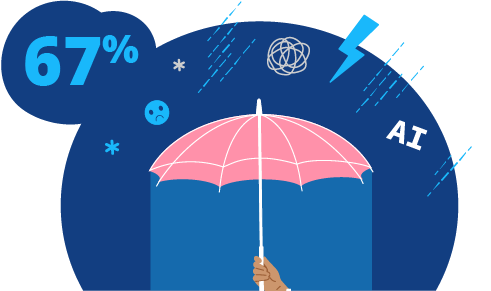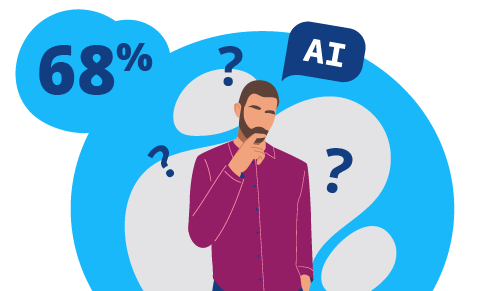Navigating the AI Era: Five Key Insights for Managing Change

Aug 22, 2025 | 4 min read
We’ve spent a fair amount of time talking about change over the last few years, and that’s for good reason. After decades in a predictable stasis, the world of work has become about as unpredictable as the weather. One day things are moving towards stability and calm, a “new normal.” Then the markets shift, policies change, and everything swings in a new direction, causing everyone to buckle up for what the next quarter will bring. More layoffs? A new work model? Perhaps a new technology we have to learn and leverage?
It's no doubt that while the economy drives a significant amount of this change and organizations do their best to calibrate and safeguard their people and their businesses, technology has become a major influence in the world of work. Gone are the days of Excel being the trickiest program we must learn, did you know that generative AI can help you create your five-year financial outlook based on historical trends or your marketing strategy based on content production and new product timelines?
The power of AI is hard to conceptualize, especially for those of us who still have a hard time mastering Excel (for the last time, where is the Wrap Text button?!). But as priorities shift, budgets get tighter, and workloads get larger, learning this technology has become a top focus in many organizations across all industries.
What does this mean for people in everyday jobs that are just trying to gain their footing amidst so much change? Change fatigue is a serious concern and we wanted to understand how people are feeling now. We surveyed 1,685 individuals to dive deeper into how this rapid pace of change is impacting stress levels, who is being impacted most, and what leaders can do to help their people stabilize in an uncertain time.
Read on for our five key insights that illuminate the current state of change management and what organizations must do to thrive in the AI era.
1. Organizations Are Facing a Change Cascade Crisis
The pace of change is relentless. A striking 67% of respondents expect even more change ahead, creating a “cascade crisis” where employees are continuously destabilized by new disruptions before they’ve had a chance to recover from the last. Imagine a wave pool where people are still gasping for air and the next wave comes. This constant churn is taking a toll: 35% of respondents report experiencing severe stress levels.

67% expect even more change in the near future.
This combination of ongoing disruption and elevated stress signals a growing risk of change fatigue. When employees are perpetually in reactive mode, their ability to adapt, innovate, and perform diminishes. Organizations must recognize that managing change isn’t just about implementing new systems, it’s also about creating space for recovery and resilience.
2. Middle Managers Are Caught in a Leadership Squeeze
Middle managers are often the key that unlocks successful change initiatives, but our data shows they’re under immense pressure. Over half (52%) of managers feel responsible for helping their teams navigate change, yet only 45% feel adequately supported by senior leadership. This gap leaves managers in a difficult position as they are expected to lead without the tools or backing they need to be successful.

52% of managers feel responsible for leading through change but lack adequate support.
Interestingly, the biggest challenge for managers isn’t employee resistance (only 13% cited this), but rather a lack of clear information and the struggle to balance productivity with adaptation. These findings suggest that organizations must equip managers with the clarity, resources, and authority to guide their teams effectively.
3. One Critical Need Dominates All Others When Navigating Change: Communication
When asked what they need most during times of change, 41% of employees pointed to clear communication. This was the top response across roles, industries, and types of change. It’s a powerful reminder that even the most sophisticated change strategies will falter without transparent, consistent messaging.
Clear communication helps employees understand the “why” behind changes, what’s expected of them, and how they’ll be supported. It reduces uncertainty, builds trust, and fosters engagement. In the context of AI adoption, where anxiety about the unknown can be prevalent, it becomes even more vital. Organizations must prioritize clarity at every stage of the change process.
4. AI Readiness Exists, But Organizational Support Doesn’t
The good news: we found that employees are largely open to AI. A significant 68% report feeling excited or curious about AI, and 44% already use it at least weekly. This enthusiasm presents a major opportunity for organizations to harness AI’s potential.

68% report feeling excited or curious about AI.
The challenge? Many organizations aren’t keeping pace. One-third of respondents (33%) are unsure whether their organization even has AI policies, and 30% don’t know how their employer views AI usage. This disconnect between employee readiness and organizational support is a red flag.
To successfully integrate AI, organizations must move beyond enthusiasm and into action. That means developing clear policies, offering robust training, and embedding AI into broader change management strategies.
5. Training Approaches Are Fundamentally Mismatched
Despite the constant nature of change, only 18% of respondents say they receive comprehensive change training. Yet 76% believe such training would be valuable. This mismatch reveals a systemic issue: organizations are managing individual changes reasonably well, but they’re not preparing employees for the ongoing, cumulative impact of continuous transformation.
The solution isn’t just better change management techniques (though that is an essential element), it’s a holistic cultural shift. Organizations must build change-resilient cultures that empower middle managers, integrate support systems, and communicate clearly about both current changes and future AI integration. This means moving from reactive change management to proactive change leadership.
Whether we are ready or not, the AI era is here, and with it comes (even more) unprecedented change. Our research shows that while employees are open to innovation, they’re also overwhelmed by the pace and volume of transformation. To navigate this landscape successfully, organizations must take a comprehensive approach to change.
How to Build a Change-Resilient Culture
- Create space for recovery between disruptions
- Support managers with clear information and leadership backing
- Prioritize communication as a strategic tool
- Align AI enthusiasm with organizational readiness
Change is inevitable, but fatigue, confusion, and resistance don’t have to be. By addressing these core needs, organizations can build a workforce that’s not only ready for AI, but ready for whatever comes next. Learning Excel, though, that’s still a mystery.
Wiley’s suite of professional solutions provides a structure and common language to help empower entire organizations with the skills needed to get to the next level. From building better teams with The Five Behaviors®, and improving understanding to create engaged, collaborative, and adaptive cultures with Everything DiSC® on Catalyst™, helping you make confident hiring decisions with PXT Select®, or unlocking the power of leadership at every level with The Leadership Challenge®, Wiley has innovative solutions that help make the workplace a better place.
Wiley Workplace Intelligence conducts in-depth research on key workplace issues by gathering insights from individual contributors, managers, and leaders. Wiley Workplace Intelligence then analyzes these findings to provide actionable solutions that are shared in our blog.
